#cloud computing in automotive
Explore tagged Tumblr posts
Link
Rise of connected vehicles and telematics is driving the use of cloud computing in automobile industry. Geographically, asia-pacific region is the major...
0 notes
Text
2024 team sponsors recap!
this is completely irrelevant to F1 but i study and do these stuffs for a living sooo 😩😩 2023 sponsors are based on the sponsors that are there at the beginning of the season (new sponsors that join in the middle of the season will be classified as 2024's)
Mercedes AMG Petronas F1 Team:
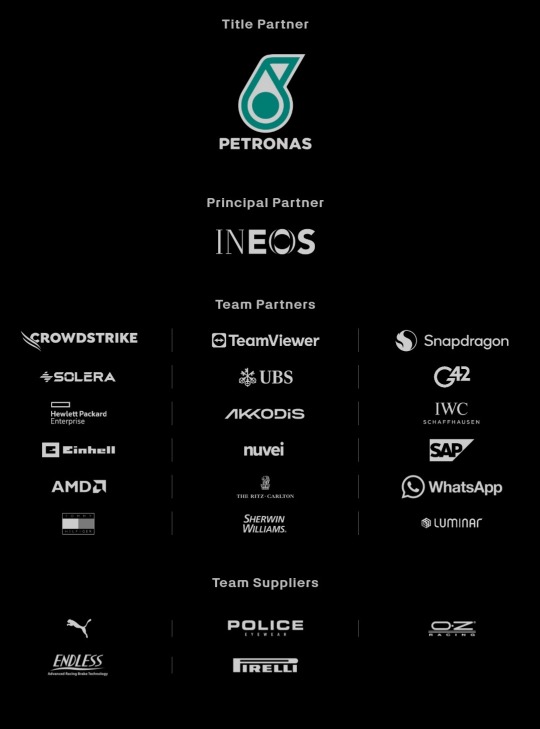
New sponsors: Whatsapp, Luminar (American tech company), SAP (German software company), nuvei (Canadian credit card services), Sherwin Williams (American painting company) 2024 data last update: 2024/02/14
Old sponsors that left: Monster Energy, Pure Storage (American technology company), fastly (American cloud computing services), Axalta (American painting company), Eight sleep (American mattresses company) 2023 data last update: 2023/01/07
Oracle Red Bull Racing F1 Team:
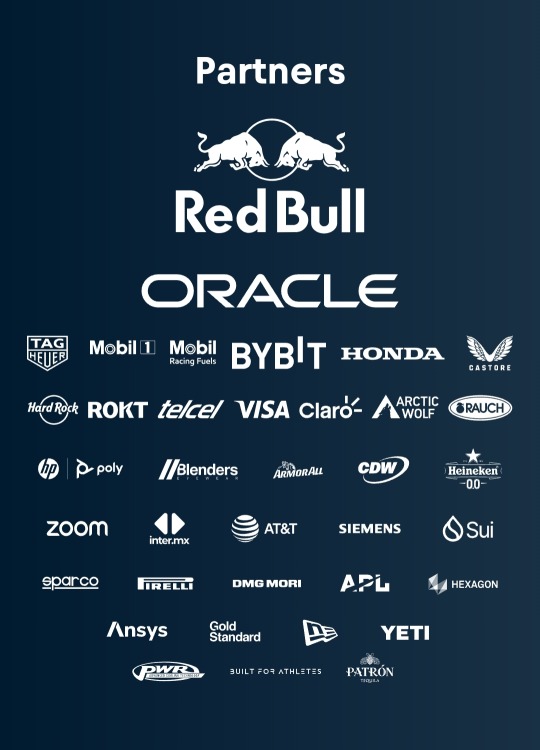
New sponsors: Yeti (American cooler manufacturer, joined later in 2023), APL (American footwear/athletic apparel manufacturer, joined later in 2023), CDW (American IT company, joined later in 2023), Sui (American tech app by Mysten Labs, joined later in 2023), Patron Tequila (Mexican alcoholic beverages company, joined later in 2023) 2024 data last update: 2024/02/15
Old sponsors that left: CashApp, Walmart, Therabody (American wellness technology company), Ocean Bottle (Norwegian reusable bottle manufacturer), PokerStars (Costa Rican gambling site), Alpha Tauri (? no info if they're official partners or not but Austrian clothing company made by Red Bull), BMC (Switzerland bicycle/cycling manufacturer), Esso (American fuel company, subsidiary of ExxonMobil), Hewlett Packard Enterprise (American technology company) 2023 data last update: 2023/03/07
More: Esso is a subsidiary of Mobil so there's possibility they merged or something
Scuderia Ferrari:
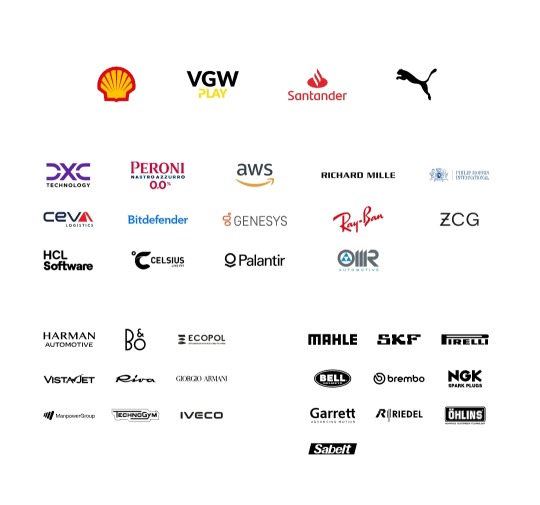
New sponsors: VGW Play (Australian tech game company, joined later in 2023), DXC Technology (American IT company, joined later in 2023), Peroni (Italian brewing company), Z Capital Group/ZCG (American private asset management/merchant bank company), Celsius (Swedish energy drink manufacturer) 2024 data last update: 2024/02/15
Old sponsors that left: Mission Winnow (American content lab by Phillip Morris International aka Marlboro), Estrella Garcia (Spanish alcoholic beverages manufacturer), Frecciarossa (Italian high speed train company) 2023 data last update: 2023/02/16
More: Mission Winnow is a part of Phillip Morris International. They are no longer listed as team sponsor but PMI is listed instead.
(starting here, 2023 data last update is 2023/02/23 and 2024 data last update is 2024/02/15)
McLaren F1 Team: (Only McLaren RACING's data is available idk if some of these are XE/FE team partners but anw..)
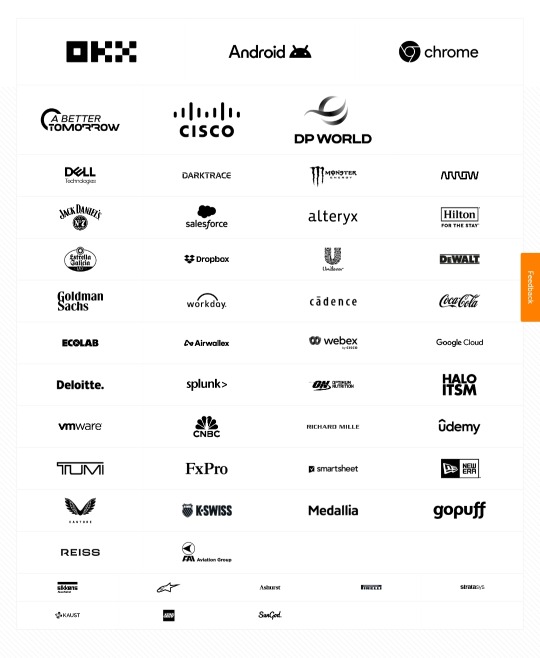
New sponsors: Monster Energy, Salesforce (American cloud based software company, joined later in 2023), Estrella Garcia (Spanish alcoholic beverages manufacturer), Dropbox (American file hosting company), Workday (American system software company, joined later in 2023), Ecolab (American water purification/hygiene company), Airwallex (Australian financial tech company), Optimum Nutrition (American nutritional supplement manufacturer), Halo ITSM (American software company, joined later in 2023), Udemy (American educational tech company, joined later in 2023), New Era (American cap manufacturer, joined in 2023), K-Swiss (American shoes manufacturer, joined later in 2023), Alpinestars (Italian motorsports safety equipment manufacturer)
Old sponsors that left: DP World (Emirati logistics company), EasyPost (American shipping API company), Immersive Labs (UK cybersecurity training company?), Logitech, Mind (UK mental health charity), PartyCasino (UK? online casino site), PartyPoker (American? gambling site), Sparco (Italian auto part & accessory manufacturer), Tezos (Switzerland crypto company)
Aston Martin Aramco F1 Team:

New sponsors: Valvoline (American retail automotives service company, joined later in 2023), NexGen (Canadian sustainable? fuel company), Banco Master (Brazilian digital banking platform, joined later in 2023), ServiceNow (American software company, joined later in 2023), Regent Seven Seas Cruise, Wolfgang Puck (Austrian-American chef and restaurant owner, joined later in 2023), Financial Times (British business newspaper), OMP (Italian racing safety equipment manufacturer), stichd (Netherlands fashion & apparel manufacturer)
Old sponsors that left: Alpinestars (Italian motorsports safety equipment manufacturer), crypto.com (Singaporean cryptocurrency company), ebb3 (UK? software company), Pelmark (UK fashion and apparel manufacturer), Peroni (Italian brewing company), Porto Seguro (Brazilian insurance company), Socios (Malta's blockchain-based platform), XP (Brazilian investment company)
Stake F1 Team (prev. Alfa Romeo):
???? Can't found their website (might be geoblocked in my country???)
BWT Alpine F1 Team:
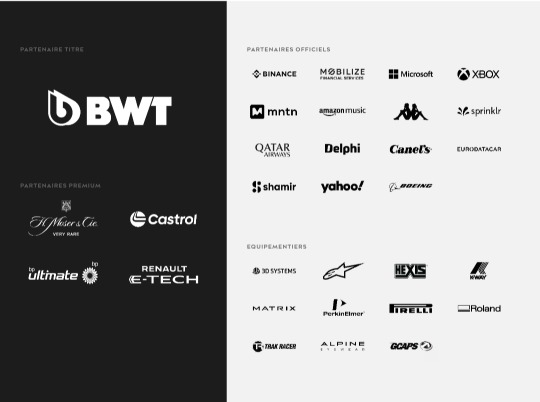
New sponsors: MNTN (American software company), H. Moser & Cie (Switzerland watch manufacturer), Amazon Music
Old sponsors that left: Bell & Ross (French watch company), Ecowatt (??? afaik French less-energy smthn smthn company), Elysium (French? American? Software company), KX (UK software company), Plug (American electrical equipment manufacturing company)
Visa CashApp RB F1 Team (prev. Scuderia Alpha Tauri):
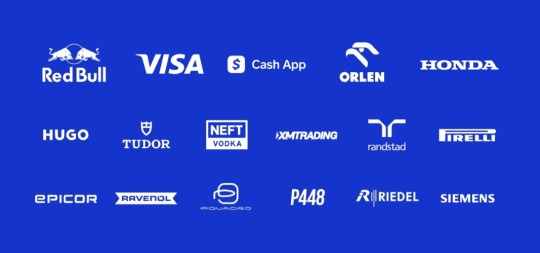
New Sponsors: Visa, CashApp, Hugo Boss, Tudor, Neft Vodka (Austrian alcoholic beverages company), Piquadro (Italian luxury bag manufacturer)
Old sponsors that left: Buzz (?), Carl Friedrik (UK travel goods manufacturer), Flex Box (Hongkong? shipping containers manufacturer), GMG (Emirati global wellbeing company), RapidAPI (American API company)
Haas F1 Team:

New sponsors: New Era (American cap manufacturer, joined later in 2023)
Old sponsors that left: Hantec Markets (Hongkong capital markets company), OpenSea (American NFT/Crypto company)
Williams Racing:

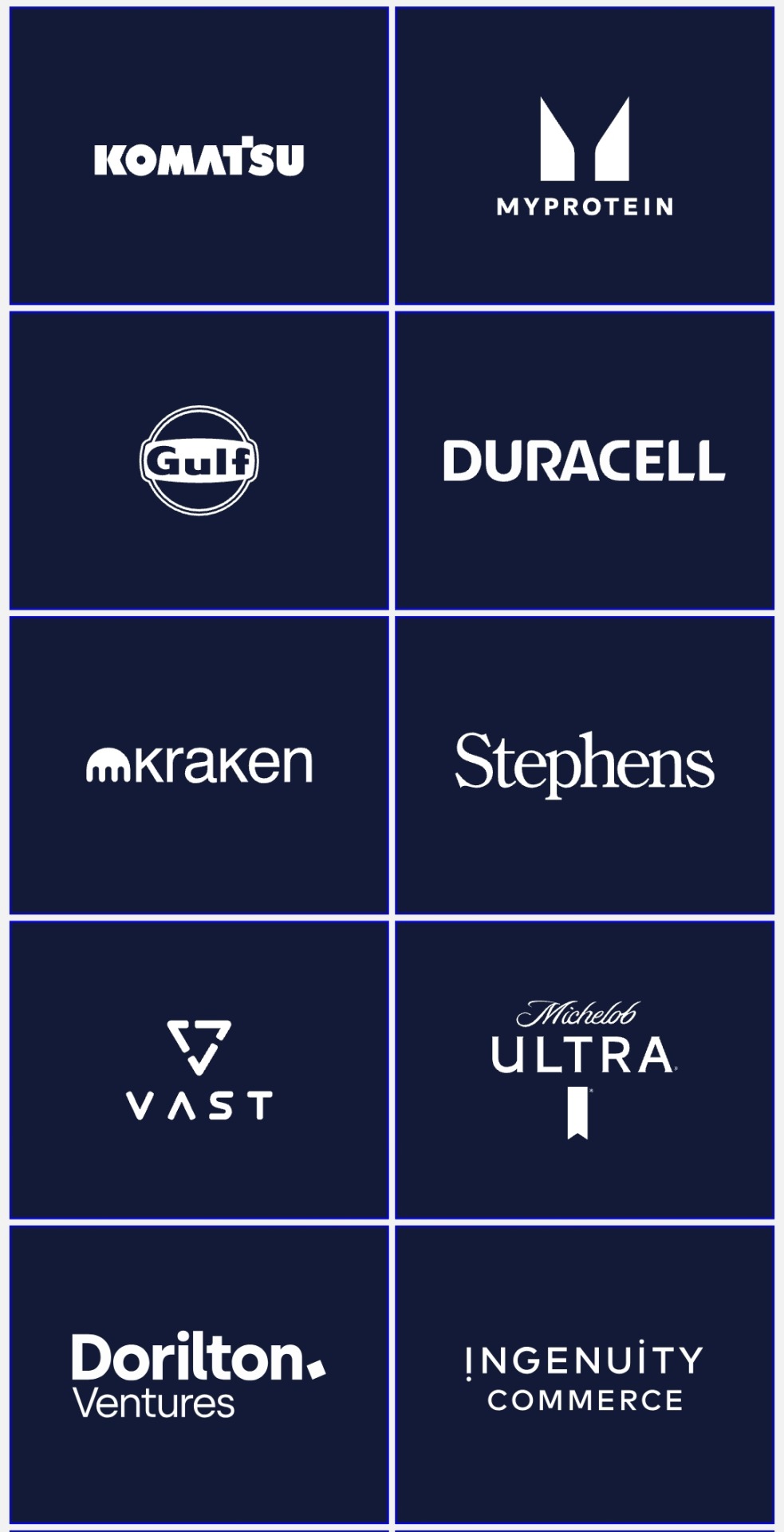
New sponsors: Komatsu, MyProtein (British bodybuilding supplement), Kraken (American crypto company, joined later in 2023), VAST Data (American tech company), Ingenuity Commerce (UK e-commerce platform), Puma (joined later in 2023)
Old sponsors that left: Acronis (Swiss software company), Bremont (British watch manufacturer), Dtex Systems (American? cybersecurity company), Financial Times (British business newspaper), Jumeirah Hotels & Resorts, KX (UK software company), OMP (Italian racing safety equipment manufacturer), PPG (American painting manufacturer), Umbro (English sports equipment manufacturer), Zeiss (German opticals/optometrics manufacturing company)
#mercedes amg petronas#red bull racing#scuderia ferrari#visa cash app rb#haas f1 team#mclaren f1#aston martin#alpine f1#williams racing#stake f1 team#f1#ari's rant#sponsor talks
42 notes
·
View notes
Text

Pioneering the Future of Transportation: Innovative Car Engine Technologies
The automotive industry is undergoing a revolutionary transformation, driven by innovative car engine technologies that are shaping the future of nationwide car shipping. These advancements are crucial in improving vehicle performance, efficiency, and sustainability, paving the way for a new era of mobility. As environmental concerns and regulatory pressures mount, automakers are investing heavily in developing cutting-edge engine solutions that not only enhance performance but also reduce emissions and improve fuel economy.
Emerging Car Engine Solutions
1. Electric Powertrains
One of the most significant innovations in car engine technology is the rapid development of electric powertrains. Major automakers are investing heavily in electric vehicle (EV) production, aiming to become global leaders in electric mobility by 2030. Electric powertrains offer several advantages:
Zero direct emissions, contributing to reduced air pollution
Higher energy efficiency compared to traditional internal combustion engines
Instant torque delivery, providing improved acceleration and performance
By 2030, it is expected that 55 percent of all cars sold in Europe will be fully electric, highlighting the growing importance of this technology.
2. Advanced Internal Combustion Engines
While electric vehicles are gaining traction, innovative internal combustion engine designs are also being developed to improve efficiency and reduce emissions. These advancements include:
Variable compression ratio engines that adjust compression based on driving conditions
Homogeneous charge compression ignition (HCCI) engines that combine the best features of gasoline and diesel engines
These technologies aim to squeeze more power and efficiency out of traditional fuel sources, providing a bridge between conventional and fully electric vehicles.
3. Hybrid Powertrains
Hybrid powertrains, which combine internal combustion engines with electric motors, continue to evolve and offer a balance between traditional and electric technologies. Advanced hybrid systems provide:
Improved fuel efficiency through regenerative braking and electric-only operation at low speeds
Reduced emissions while maintaining long-range capabilities
Enhanced performance through the combination of electric and combustion power
4. Hydrogen Fuel Cell Technology
While still in the early stages of adoption, hydrogen fuel cell technology is gaining attention as a potential alternative to battery-electric vehicles. Fuel cell engines offer:
Zero emissions, producing only water vapor as a byproduct
Faster refueling times compared to battery charging
Longer range capabilities, especially for larger vehicles from the nationwide auto transport companies and long-distance transportation
The Future of Automotive Innovation

The continued development of advanced car engine technologies is set to transform the automotive landscape dramatically. As these innovations progress, we can expect to see:
Enhanced Vehicle Intelligence: The integration of AI and machine learning in engine management systems will lead to smarter, more responsive vehicles. For instance, BMW Group and NVIDIA Corporation's collaboration aims to integrate AI computing platforms into vehicles, enabling advanced autonomous driving capabilities and intelligent engine control features.
Improved Connectivity: The automotive industry is moving towards a more connected future. Ford Motor Company and Amazon Web Services (AWS) are developing a cloud-based platform for next-generation connected vehicles, enabling features like over-the-air software updates and predictive maintenance for engine systems.
Sustainable Transportation Solutions: With a focus on electric powertrains, hydrogen fuel cells, and more efficient combustion engines, the automotive industry is actively working towards reducing its environmental impact. This shift is expected to accelerate, with more automakers committing to sustainable practices and products.
Enhanced Performance and Efficiency: The combination of advanced engine control systems and innovative powertrain technologies will result in vehicles that are not only more efficient but also offer improved performance across various driving conditions.
Automakers are playing a crucial role in driving these innovations forward. Companies like General Motors, Volvo, Aston Martin, and Jaguar Land Rover are planning to manufacture only electric cars in the foreseeable future, demonstrating their commitment to sustainable mobility solutions.
Additionally, collaborative efforts between automakers, engine suppliers, research institutions, and government agencies are facilitating technology innovation, standardization, and scale economies that drive down costs and accelerate the adoption of cleaner, more efficient engines.
The future of auto transport services in california is being shaped by remarkable advancements in car engine technologies. From electric powertrains to advanced internal combustion engines and hydrogen fuel cells, these innovations are not only enhancing vehicle performance and efficiency but also contributing to a more sustainable automotive ecosystem.
As we move forward, the continued collaboration between automakers, nationwide car carriers, and automotive industries will be essential in realizing the full potential of these groundbreaking technologies, ultimately transforming the way we travel and interact with our vehicles.
The automotive engine market is expected to grow from USD 94 billion in 2022 to USD 130.63 billion by 2028, with a CAGR of 5.48%. This growth underscores the importance of innovative engine technologies in shaping the future of the best nationwide auto transport.
As these technologies continue to evolve, they will not only revolutionize the driving experience but also play a crucial role in addressing global environmental challenges and creating a more sustainable future for mobility.
vimeo
9 notes
·
View notes
Text
CNC development history and processing principles

CNC machine tools are also called Computerized Numerical Control (CNC for short). They are mechatronics products that use digital information to control machine tools. They record the relative position between the tool and the workpiece, the start and stop of the machine tool, the spindle speed change, the workpiece loosening and clamping, the tool selection, the start and stop of the cooling pump and other operations and sequence actions on the control medium with digital codes, and then send the digital information to the CNC device or computer, which will decode and calculate, issue instructions to control the machine tool servo system or other actuators, so that the machine tool can process the required workpiece.

1. The evolution of CNC technology: from mechanical gears to digital codes
The Beginning of Mechanical Control (late 19th century - 1940s)
The prototype of CNC technology can be traced back to the invention of mechanical automatic machine tools in the 19th century. In 1887, the cam-controlled lathe invented by American engineer Herman realized "programmed" processing for the first time by rotating cams to drive tool movement. Although this mechanical programming method is inefficient, it provides a key idea for subsequent CNC technology. During World War II, the surge in demand for military equipment accelerated the innovation of processing technology, but the processing capacity of traditional machine tools for complex parts had reached a bottleneck.
The electronic revolution (1950s-1970s)
After World War II, manufacturing industries mostly relied on manual operations. After workers understood the drawings, they manually operated machine tools to process parts. This way of producing products was costly, inefficient, and the quality was not guaranteed. In 1952, John Parsons' team at the Massachusetts Institute of Technology (MIT) developed the world's first CNC milling machine, which input instructions through punched paper tape, marking the official birth of CNC technology. The core breakthrough of this stage was "digital signals replacing mechanical transmission" - servo motors replaced gears and connecting rods, and code instructions replaced manual adjustments. In the 1960s, the popularity of integrated circuits reduced the size and cost of CNC systems. Japanese companies such as Fanuc launched commercial CNC equipment, and the automotive and aviation industries took the lead in introducing CNC production lines.
Integration of computer technology (1980s-2000s)
With the maturity of microprocessor and graphical interface technology, CNC entered the PC control era. In 1982, Siemens of Germany launched the first microprocessor-based CNC system Sinumerik 800, whose programming efficiency was 100 times higher than that of paper tape. The integration of CAD (computer-aided design) and CAM (computer-aided manufacturing) software allows engineers to directly convert 3D models into machining codes, and the machining accuracy of complex surfaces reaches the micron level. During this period, equipment such as five-axis linkage machining centers came into being, promoting the rapid development of mold manufacturing and medical device industries.
Intelligence and networking (21st century to present)
The Internet of Things and artificial intelligence technologies have given CNC machine tools new vitality. Modern CNC systems use sensors to monitor parameters such as cutting force and temperature in real time, and use machine learning to optimize processing paths. For example, the iSMART Factory solution of Japan's Mazak Company achieves intelligent scheduling of hundreds of machine tools through cloud collaboration. In 2023, the global CNC machine tool market size has exceeded US$80 billion, and China has become the largest manufacturing country with a production share of 31%.
2. CNC machining principles: How code drives steel
The essence of CNC technology is to convert the physical machining process into a control closed loop of digital signals. Its operation logic can be divided into three stages:
Geometric Modeling and Programming
After building a 3D model using CAD software such as UG and SolidWorks, CAM software “deconstructs” the model: automatically calculating parameters such as tool path, feed rate, spindle speed, and generating G code (such as G01 X100 Y200 F500 for linear interpolation to coordinates (100,200) and feed rate 500mm/min). Modern software can even simulate the material removal process and predict machining errors.
Numerical control system analysis and implementation
The "brain" of CNC machine tools - the numerical control system (such as Fanuc 30i, Siemens 840D) converts G codes into electrical pulse signals. Taking a three-axis milling machine as an example, the servo motors of the X/Y/Z axes receive pulse commands and convert rotary motion into linear displacement through ball screws, with a positioning accuracy of up to ±0.002mm. The closed-loop control system uses a grating ruler to feedback position errors in real time, forming a dynamic correction mechanism.
Multi-physics collaborative control
During the machining process, the machine tool needs to coordinate multiple parameters synchronously: the spindle motor drives the tool to rotate at a high speed of 20,000 rpm, the cooling system sprays atomized cutting fluid to reduce the temperature, and the tool changing robot completes the tool change within 0.5 seconds. For example, when machining titanium alloy blades, the system needs to dynamically adjust the cutting depth according to the hardness of the material to avoid tool chipping.


3. The future of CNC technology: cross-dimensional breakthroughs and industrial transformation
Currently, CNC technology is facing three major trends:
Combined: Turning and milling machine tools can complete turning, milling, grinding and other processes on one device, reducing clamping time by 90%;
Additive-subtractive integration: Germany's DMG MORI's LASERTEC series machine tools combine 3D printing and CNC finishing to directly manufacture aerospace engine combustion chambers;
Digital Twin: By using a virtual machine tool to simulate the actual machining process, China's Shenyang Machine Tool's i5 system has increased debugging efficiency by 70%.


From the meshing of mechanical gears to the flow of digital signals, CNC technology has rewritten the underlying logic of the manufacturing industry in 70 years. It is not only an upgrade of machine tools, but also a leap in the ability of humans to transform abstract thinking into physical entities. In the new track of intelligent manufacturing, CNC technology will continue to break through the limits of materials, precision and efficiency, and write a new chapter for industrial civilization.
#prototype machining#cnc machining#precision machining#prototyping#rapid prototyping#machining parts
2 notes
·
View notes
Text
Edge Computing Market Disruption: 7 Startups to Watch

Edge Computing Market Valuation and Projections
The global edge computing market is undergoing a transformative evolution, with projections estimating an edge computing market size escalation from USD 15.96 billion in 2023 to approximately USD 216.76 billion by 2031, marking a compound annual growth rate (CAGR) of 33.6%. This unprecedented trajectory is being driven by rising demand for real-time data processing, the proliferation of Internet of Things (IoT) devices, and the deployment of 5G infrastructure worldwide.
Request Sample Report PDF (including TOC, Graphs & Tables): https://www.statsandresearch.com/request-sample/40540-global-edge-computing-market
Accelerated Demand for Real-Time Data Processing
Edge computing is revolutionizing the digital ecosystem by decentralizing data processing, shifting it from core data centers to the edge of the network—closer to the point of data generation. This architectural transformation is enabling instantaneous insights, reduced latency, and optimized bandwidth usage, which are critical in sectors requiring rapid decision-making.
Industries such as automotive, healthcare, telecommunications, and manufacturing are leading adopters of edge technologies to empower smart operations, autonomous functionality, and predictive systems.
Get up to 30%-40% Discount: https://www.statsandresearch.com/check-discount/40540-global-edge-computing-market
Edge Computing Market Segmentation Analysis:
By Component
Hardware
Edge computing hardware includes edge nodes, routers, micro data centers, servers, and networking gear. These devices are designed to endure harsh environmental conditions while delivering low-latency data processing capabilities. Companies are investing in high-performance edge servers equipped with AI accelerators to support intelligent workloads at the edge.
Software
Software solutions in edge environments include container orchestration tools, real-time analytics engines, AI inference models, and security frameworks. These tools enable seamless integration with cloud systems and support distributed data management, orchestration, and real-time insight generation.
Services
Edge services encompass consulting, deployment, integration, support, and maintenance. With businesses adopting hybrid cloud strategies, service providers are essential for ensuring compatibility, uptime, and scalability of edge deployments.
By Application
Industrial Internet of Things (IIoT)
Edge computing plays a vital role in smart manufacturing and Industry 4.0 initiatives. It facilitates predictive maintenance, asset tracking, process automation, and remote monitoring, ensuring enhanced efficiency and minimized downtime.
Smart Cities
Municipalities are leveraging edge computing to power traffic control systems, surveillance networks, waste management, and public safety infrastructure, enabling scalable and responsive urban development.
Content Delivery
In media and entertainment, edge solutions ensure low-latency content streaming, localized data caching, and real-time audience analytics, thereby optimizing user experience and reducing network congestion.
Remote Monitoring
Critical infrastructure sectors, including energy and utilities, employ edge computing for pipeline monitoring, grid analytics, and remote equipment diagnostics, allowing for proactive threat identification and response.
By Industry Vertical
Manufacturing
Edge solutions in manufacturing contribute to real-time production analytics, defect detection, and logistics automation. With AI-powered edge devices, factories are becoming increasingly autonomous and intelligent.
Healthcare
Hospitals and clinics implement edge computing to support real-time patient monitoring, diagnostic imaging processing, and point-of-care data analysis, enhancing treatment accuracy and responsiveness.
Transportation
The sector is utilizing edge technology in autonomous vehicle systems, smart fleet tracking, and intelligent traffic signals. These systems demand ultra-low latency data processing to function safely and efficiently.
Energy & Utilities
Edge computing enables smart grid optimization, renewable energy integration, and predictive fault detection, allowing utilities to manage resources with greater precision and sustainability.
Retail & Others
Retailers deploy edge devices for personalized marketing, real-time inventory management, and customer behavior analysis, enabling hyper-personalized and responsive shopping experiences.
Key Drivers Behind Edge Computing Market Growth:
1. IoT Proliferation and Data Deluge
With billions of connected devices transmitting real-time data, traditional cloud architectures cannot meet the bandwidth and latency demands. Edge computing solves this by processing data locally, eliminating unnecessary round trips to the cloud.
2. 5G Deployment
5G networks offer ultra-low latency and high throughput, both essential for edge applications. The synergy between 5G and edge computing is pivotal for real-time services like AR/VR, telemedicine, and autonomous navigation.
3. Hybrid and Multi-Cloud Strategies
Enterprises are embracing decentralized IT environments. Edge computing integrates with cloud-native applications to form hybrid infrastructures, offering agility, security, and location-specific computing.
4. Demand for Enhanced Security and Compliance
By localizing sensitive data processing, edge computing reduces exposure to cyber threats and supports data sovereignty in regulated industries like finance and healthcare.
Competitive Landscape
Leading Players Shaping the Edge Computing Market
Amazon Web Services (AWS) – Offers AWS Wavelength and Snowball Edge for low-latency, high-performance edge computing.
Microsoft Azure – Delivers Azure Stack Edge and Azure Percept for AI-powered edge analytics.
Google Cloud – Provides Anthos and Edge TPU for scalable, intelligent edge infrastructure.
IBM – Offers edge-enabled Red Hat OpenShift and hybrid edge computing solutions for enterprise deployment.
NVIDIA – Powers edge AI workloads with Jetson and EGX platforms.
Cisco Systems – Delivers Fog Computing and edge networking solutions tailored to enterprise-grade environments.
Dell Technologies – Supplies ruggedized edge gateways and scalable edge data center modules.
Hewlett Packard Enterprise (HPE) – Delivers HPE Edgeline and GreenLake edge services for data-intensive use cases.
FogHorn Systems & EdgeConneX – Innovators specializing in industrial edge analytics and data center edge infrastructure respectively.
Edge Computing Market Regional Insights
North America
A mature digital infrastructure, coupled with high IoT adoption and strong cloud vendor presence, makes North America the dominant regional edge computing market.
Asia-Pacific
Driven by rapid urbanization, smart city initiatives, and industrial automation in China, India, and Japan, Asia-Pacific is projected to experience the fastest CAGR during the forecast period.
Europe
The region benefits from strong government mandates around data localization, Industry 4.0 initiatives, and investments in telecom infrastructure.
Middle East and Africa
Emerging adoption is evident in smart energy systems, oilfield monitoring, and urban digital transformation projects.
South America
Growth in agritech, mining automation, and public safety systems is propelling the edge market in Brazil, Chile, and Argentina.
Purchase Exclusive Report: https://www.statsandresearch.com/enquire-before/40540-global-edge-computing-market
Edge Computing Market Outlook and Conclusion
Edge computing is not just an enabler but a strategic imperative for digital transformation in modern enterprises. As we move deeper into an AI-driven and hyperconnected world, the integration of edge computing with 5G, IoT, AI, and cloud ecosystems will redefine data management paradigms.
Businesses investing in edge infrastructure today are setting the foundation for resilient, intelligent, and real-time operations that will determine industry leadership in the years ahead. The edge is not the future—it is the present frontier of competitive advantage.
Our Services:
On-Demand Reports: https://www.statsandresearch.com/on-demand-reports
Subscription Plans: https://www.statsandresearch.com/subscription-plans
Consulting Services: https://www.statsandresearch.com/consulting-services
ESG Solutions: https://www.statsandresearch.com/esg-solutions
Contact Us:
Stats and Research
Email: [email protected]
Phone: +91 8530698844
Website: https://www.statsandresearch.com
1 note
·
View note
Text
FPGA Market - Exploring the Growth Dynamics

The FPGA market is witnessing rapid growth finding a foothold within the ranks of many up-to-date technologies. It is called versatile components, programmed and reprogrammed to perform special tasks, staying at the fore to drive innovation across industries such as telecommunications, automotive, aerospace, and consumer electronics. Traditional fixed-function chips cannot be changed to an application, whereas in the case of FPGAs, this can be done. This brings fast prototyping and iteration capability—extremely important in high-flux technology fields such as telecommunications and data centers. As such, FPGAs are designed for the execution of complex algorithms and high-speed data processing, thus making them well-positioned to handle the demands that come from next-generation networks and cloud computing infrastructures.
In the aerospace and defense industries, FPGAs have critically contributed to enhancing performance in systems and enhancing their reliability. It is their flexibility that enables the realization of complex signal processing, encryption, and communication systems necessary for defense-related applications. FPGAs provide the required speed and flexibility to meet the most stringent specifications of projects in aerospace and defense, such as satellite communications, radar systems, and electronic warfare. The ever-improving FPGA technology in terms of higher processing power and lower power consumption is fueling demand in these critical areas.
Consumer electronics is another upcoming application area for FPGAs. From smartphones to smart devices, and finally the IoT, the demand for low-power and high-performance computing is on the rise. In this regard, FPGAs give the ability to integrate a wide array of varied functions onto a single chip and help in cutting down the number of components required, thereby saving space and power. This has been quite useful to consumer electronics manufacturers who wish to have state-of-the-art products that boast advanced features and have high efficiency. As IoT devices proliferate, the role of FPGAs in this area will continue to foster innovation.
Growing competition and investments are noticed within the FPGA market, where key players develop more advanced and efficient products. The performance of FPGAs is increased by investing in R&D; the number of features grows, and their cost goes down. This competitive environment is forcing innovation and a wider choice availability for end-users is contributing to the growth of the whole market.
Author Bio -
Akshay Thakur
Senior Market Research Expert at The Insight Partners
2 notes
·
View notes
Text
Premarket U.S. Stock Movers: Tesla, Macy’s, Coinbase, Nio, Shell, Amazon

In today's early trading, the U.S. stock market is already buzzing with notable movements among key players. Investors and analysts are closely monitoring the premarket activity of several prominent stocks, each showing distinctive performance dynamics.
Tesla (NASDAQ) has started the day on a positive note, with its stock rising by 1.8%. This upward movement follows recent market optimism surrounding Tesla's innovative developments in electric vehicles and sustainable energy solutions. As a pioneering force in the automotive industry, Tesla continues to capture investor interest with its innovative technological advancements and ambitious growth strategies.
Macy’s (NYSE) is another standout performer in the premarket, showcasing a robust 6.8% increase. This surge reflects renewed investor confidence in the retail giant's ability to navigate challenges and capitalize on evolving consumer trends. Macy's ongoing efforts to enhance its digital capabilities and strategic initiatives in omnichannel retailing are positioning the company for sustained growth in a competitive market landscape.
Coinbase (NASDAQ), however, faces a 4.6% decline in its premarket trading. The cryptocurrency exchange platform is experiencing volatility amidst regulatory scrutiny and market fluctuations in digital assets. Despite its leadership in the digital currency space, Coinbase's stock performance underscores the inherent volatility and regulatory uncertainties impacting the crypto industry.
Nio (NYSE), known for its electric vehicle offerings, is witnessing a 2.3% decrease in its American Depositary Receipts (ADRs) during premarket trading. This decline comes amid broader sectoral challenges and market sentiment towards growth stocks in the EV sector. Nio continues to navigate through supply chain disruptions and competitive pressures as it strives to expand its market presence globally.
Shell (LON) ADRs, representing Royal Dutch Shell, have shown a modest 1.1% rise in premarket trading. As a global energy leader, Shell's stock performance reflects investor sentiment toward energy markets and macroeconomic factors influencing oil and gas prices. The company's strategic focus on sustainable energy transitions and operational resilience in a dynamic energy landscape remains pivotal amid evolving market conditions.
Amazon (NASDAQ), a cornerstone of e-commerce and cloud computing services, is demonstrating a minor 0.3% change in its premarket activity. Amazon's stock movement reflects ongoing investor sentiment towards tech giants amid regulatory scrutiny and competitive pressures in digital retail and cloud computing markets. The company continues to innovate across its business segments, driving growth and adaptation to evolving consumer behaviors.
Today's premarket movements highlight the diverse dynamics shaping the U.S. stock market. Investors are navigating through a mix of sector-specific trends, regulatory developments, and macroeconomic factors influencing stock performance. As market participants analyze these early signals, the day's trading session promises to offer further insights into the evolving landscape of global financial markets.
3 notes
·
View notes
Text
Vietnamese Engineers for Outsourcing
In recent years, Vietnam has become a major player in the global IT outsourcing industry, offering a unique blend of cost-effectiveness, skilled labor, and a rapidly growing tech environment. This article dives into why Vietnam is emerging as a top choice for outsourcing IT services and highlights some of the country's leading outsourcing companies.

For a detailed look at the top IT outsourcing companies in Vietnam, check out the full article on Kaopiz's website: Top IT Outsourcing Companies in Vietnam.
Why Choose Vietnam for IT Outsourcing?
1. Cost-Effectiveness: Vietnam provides substantial cost savings compared to regions like the US, Europe, and even other outsourcing hubs in Asia, such as India and China. The relatively low labor costs make it an attractive destination for companies looking to reduce their development costs while maintaining high standards.
2. Skilled Workforce: Vietnam’s young, tech-savvy population includes a large number of IT and engineering graduates. Vietnamese developers have a strong reputation for expertise in areas like software development, AI, machine learning, and cloud computing, making the country a hub for high-quality tech talent.
3. Government Support: The Vietnamese government has actively supported the IT and BPO industries with favorable policies, tax incentives, and investments in tech education and infrastructure, further boosting Vietnam’s appeal as an outsourcing destination.
4. Cultural Compatibility: Vietnam’s work culture aligns well with Western standards, making collaboration and communication smooth for international clients.
5. Robust IT Ecosystem: Vietnam hosts a wide range of IT outsourcing companies that specialize in various services, from software development to BPO and IT consulting.
Top IT Outsourcing Companies in Vietnam If you’re considering outsourcing to Vietnam, here are some of the top companies to consider:
FPT Software Known for delivering end-to-end software services, FPT Software works with clients ranging from Fortune 500 firms to small and medium enterprises across multiple industries, including finance, healthcare, and automotive.
Kaopiz
Specializing in software development, cloud solutions, and AI integration, Kaopiz has built a reputation for quality and reliability. They focus on customer satisfaction and have a strong track record with clients globally, including partnerships with companies across Japan, Singapore, and Europe.

TMA Solutions
With over 20 years in the industry, TMA Solutions offers comprehensive IT services, including software development, BPO, and IT testing, and is known for its high-quality, customer-centric approach.
CMC Global
Providing services such as cloud solutions, software development, and IT infrastructure management, CMC Global operates in Vietnam, Japan, and Singapore and serves an international client base.
KMS Technology
KMS Technology offers a broad range of IT solutions, from cloud computing and automation testing to mobile app development. Their expertise across various tech fields has made them a trusted partner for companies worldwide.
Sotatek
A growing player in the Vietnamese IT market, Sotatek specializes in blockchain, AI, and software development, making them an excellent choice for businesses seeking advanced tech solutions.
NTT Data Vietnam
As part of the NTT Data Group, NTT Data Vietnam provides systems integration, cloud services, and digital transformation solutions for global clients.
VTI
Known for a client-centered approach, VTI offers software development and AI solutions for companies across various sectors.
Innotech Vietnam
Innotech focuses on developing solutions for banking and finance sectors, offering tailored IT services to streamline processes and enhance performance for clients.
Rikkeisoft
Rikkeisoft specializes in mobile app development, software engineering, and IT consulting, delivering personalized solutions for businesses of all sizes.

Conclusion: Why Vietnam is a Top Choice for IT Outsourcing
Vietnam's IT outsourcing industry offers a blend of cost savings, skilled labor, and a supportive government, making it an ideal outsourcing destination. With a range of services—such as software development, BPO, and cloud solutions—Vietnam’s outsourcing sector provides customized, affordable solutions for businesses of all sizes.
For companies aiming to build complex applications, optimize operations, or reduce costs, partnering with a reputable IT outsourcing provider in Vietnam, like Kaopiz, can be a strategic advantage. With Vietnam’s strong tech ecosystem and companies like Kaopiz leading the way, your IT projects are in capable hands.
#artificial intelligence#ITO#itoutsourcing#Vietnam#software engineering#software#programming#python#information technology
1 note
·
View note
Text
3D XPoint Technology Market Share Redefining High-Speed Data Storage for the Digital Era
The 3D XPoint Technology Market Share is gaining momentum as industries increasingly demand ultra-fast, non-volatile memory solutions that bridge the performance gap between DRAM and NAND flash. Developed jointly by Intel and Micron, 3D XPoint delivers exceptional speed, endurance, and low latency—revolutionizing storage architecture in data centers, AI workloads, and enterprise computing.
According to Market Share Research Future, the global 3D XPoint technology market is expected to reach USD 7.5 billion by 2030, growing at a robust CAGR of 13.3% during the forecast period. As the world generates and processes data at unprecedented speeds, the adoption of 3D XPoint is set to rise, driven by advancements in artificial intelligence, big data analytics, and cloud infrastructure.
Market Share Overview
3D XPoint (pronounced “cross point”) is a next-generation memory technology that provides persistent storage with performance closer to DRAM and endurance far superior to NAND flash. It is designed to store data in a three-dimensional matrix and can switch states up to 1,000 times faster than traditional flash memory.
This disruptive memory architecture is addressing the bottlenecks associated with latency, durability, and scalability in modern computing systems. Its ability to support high-speed random read/write access and endure millions of cycles makes it ideal for performance-intensive applications like real-time data processing, AI inference, and in-memory computing.
Enhanced Market Share Segmentation
By Type:
Standalone Memory
Used in SSDs, expansion cards
Storage-Class Memory (SCM)
Blends memory and storage into a single tier
Embedded Memory
By Application:
Enterprise Storage
Data Centers
Consumer Electronics
Automotive Electronics
Healthcare Devices
Industrial IoT Systems
By End-User:
IT & Telecom
BFSI
Healthcare
Automotive
Government
Retail & E-Commerce
By Region:
North America – Dominates the market due to early adoption of advanced memory technologies
Europe – Growth fueled by cloud computing and enterprise digitization
Asia-Pacific – Fastest-growing region, led by semiconductor manufacturing and consumer electronics demand
Rest of the World – Emerging interest in AI and defense applications
Key Trends Influencing Growth
Integration with AI and Machine Learning Workloads: The high throughput and low latency of 3D XPoint make it well-suited for AI models that require rapid data movement and decision-making.
Edge Computing Adoption: With the rise of real-time data processing at the edge, 3D XPoint is being considered for latency-sensitive environments such as autonomous vehicles and smart cities.
Hybrid Storage Architectures: Enterprises are integrating 3D XPoint with DRAM and SSDs to optimize storage hierarchies and reduce total cost of ownership.
In-Memory Databases (IMDB): 3D XPoint boosts performance in databases requiring immediate access to vast amounts of data, such as SAP HANA or Oracle Database.
Rise of Optane Products: Intel’s Optane SSDs and memory modules, powered by 3D XPoint, are gaining traction across high-performance computing markets.
Segment Insights
Standalone Memory
Standalone memory devices using 3D XPoint, such as NVMe-based SSDs, are in high demand across enterprise IT infrastructures. They offer faster boot times, application load speeds, and overall system responsiveness compared to traditional SSDs.
Storage-Class Memory (SCM)
SCM combines the benefits of DRAM and NAND flash. It enables faster storage with persistent memory capabilities, allowing systems to resume instantly and retain data without power. Adoption is rising in hyperscale data centers and mission-critical applications.
Consumer Electronics
3D XPoint is beginning to appear in high-end laptops, gaming PCs, and workstations where users seek faster load times and improved multitasking capabilities.
End-User Insights
IT & Telecom
Data centers supporting 5G, virtualization, and software-defined storage benefit significantly from 3D XPoint’s low latency and endurance. Service providers are using it to reduce response times and improve service-level agreements (SLAs).
BFSI Sector
Banks and financial institutions require real-time analytics and fraud detection. 3D XPoint supports these functions by enabling faster access to massive datasets, driving improved customer experiences and compliance.
Healthcare
Medical imaging, diagnostics, and health record processing demand rapid, secure storage solutions. 3D XPoint ensures faster retrieval of critical patient data, reducing delays in clinical workflows.
Automotive
In autonomous vehicles and infotainment systems, 3D XPoint’s resilience and high speed enhance safety and performance. Its ability to function reliably under extreme conditions makes it ideal for automotive-grade applications.
Key Players
The 3D XPoint technology ecosystem is currently limited to a few key players, with others entering the domain through partnerships and acquisitions:
Intel Corporation
Micron Technology Inc.
Western Digital Technologies
Samsung Electronics Co., Ltd.
SK hynix Inc.
Hewlett Packard Enterprise (HPE)
IBM Corporation
Dell Technologies
These companies are investing in R&D to expand the use cases of 3D XPoint, reduce costs, and integrate the technology into mainstream computing platforms.
Future Outlook
The future of 3D XPoint technology lies in its ability to disrupt memory and storage hierarchies. As edge computing, AI, and cloud-native workloads proliferate, the demand for fast, durable, and persistent memory will continue to rise.
With decreasing production costs, expanding supply chains, and broader application scopes, 3D XPoint is expected to become a core component of future computing architectures. Organizations that prioritize performance, endurance, and data integrity will increasingly migrate toward hybrid solutions powered by 3D XPoint.
Trending Report Highlights
Explore emerging technologies transforming the semiconductor and intelligent systems landscape:
Embedded Display Market Share
Embedded Subscriber Identity Module Market Share
Enterprise Manufacturing Intelligence Market Share
Ethernet Adapter Market Share
Robotic Refueling System Market Share
Roll To Roll Printing Market Share
Rugged IC Market Share
Single Mode Optical Fiber Market Share
Smart Motor Market Share
Smart Wiring Device Market Share
Sound Reinforcement Market Share
0 notes
Link
Rise of connected vehicles and telematics is driving the use of cloud computing in automobile industry. Geographically, asia-pacific region is the major...
0 notes
Text
Why AI-Powered Mapmaking is Essential to the New Era of Software-Defined Vehicles
New Post has been published on https://thedigitalinsider.com/why-ai-powered-mapmaking-is-essential-to-the-new-era-of-software-defined-vehicles/
Why AI-Powered Mapmaking is Essential to the New Era of Software-Defined Vehicles


The automotive industry is undergoing one of the most profound transformations in its history. Once defined by mechanical engineering and horsepower, today’s vehicles are increasingly shaped by code. We’re entering the era of software-defined vehicles (SDVs) where the intelligence of the car comes less from the engine block, but from lines of software. A recent study by Research and Markets projects that the global SDV market will grow from $213.5 billion in 2024 to over $1.2 trillion by 2030. That scale of growth is no surprise to those working at the intersection of software, mapping and AI. It’s a reflection of how rapidly the role of AI is expanding across every aspect of mobility.
AI will increasingly become the digital engine behind some of the most valuable vehicle functions: digital cockpits with natural language prompting, real-time navigation and dynamic routing, predictive maintenance, advanced driver-assistance systems (ADAS) and higher levels of automated driving. AI is helping to redefine and customize the driver experience. According to a recent IBM study, 74% of automotive executives believe that by 2035 vehicles will be both software-defined and AI-powered. And by then, 80% of new cars are expected to feature electric powertrains, providing an even more natural foundation for integrating vehicle systems, mapping, software and AI capabilities.
AI-Powered Mapping: The Digital Compass of SDVs
A particularly compelling example of AI’s role is in the evolution of digital mapmaking. A traditional static map is giving way to a “live” map: dynamic, constantly streamed representations of the road environment used to power an array of vehicle systems. A map is essential for safe and efficient driving in an increasingly electric, connected and automated vehicle.
A live map provides much more than simple navigation, enabling the vehicle to interpret its surroundings and make informed driving decisions in real-time. AI’s ability to detect patterns, recognize environmental changes, and update map data dynamically makes it possible for the driver (and vehicle systems) to avoid construction zones, reroute around traffic accidents and become aware of changes in road signage or speed limits.
We are already seeing live map capabilities that continuously integrate data from vehicle sensors, satellite imagery and crowdsourced input, among other sources, to reflect changing road conditions. The ability to unify multiple sources of data, automated and powered by AI and machine learning, unlocks the true potential of a live map.
The Personalized Vehicle: Intelligent, More Intuitive In-Car Experiences
The driver experience is also becoming more personalized, more intuitive and more AI-driven. We’re seeing in-vehicle AI assistants that learn to respond to natural language and recognize patterns in driver behavior, enabling vehicles to adapt to individual preferences. AI assistants now offer natural language-prompted routing, EV charging recommendations, safety alerts based on driving conditions and dynamic itinerary suggestions that incorporate stops, preferences and real-time changes.
According to IBM’s study, 75% of executives believe software-defined experiences will be the core of an automotive brand’s value by 2035. This means a driver might receive a route suggestion not just based on the shortest travel time, but also factoring in dynamic elements like real-time weather, nearby EV charger availability and previous stops such as a favorite travel center or coffee shop. Over time, the vehicle becomes more of a travel companion that continues to learn and evolve with the driver.
AI as the Foundation for Assisted and Autonomous Functions
AI is also fundamental to the continued evolution of ADAS and autonomous driving functions. It will enable improved decision-making for vehicle safety and efficiency, from lane-keeping and adaptive cruise control to pedestrian detection and object recognition.
With SDVs advancing toward higher levels of autonomy, the combination of AI-powered mapping with on-board sensor inputs like LiDAR and cameras will be essential for accurate route planning, situational awareness and regulatory compliance.
Overcoming Roadblocks: Key Challenges in AI Integration
While the transformative value of AI in SDVs is vast, and enthusiasm for AI is high, several challenges must be addressed for widespread adoption:
Data Integrity & Security: AI relies on large volumes of data, raising concerns about securing sensitive information while maintaining real-time accuracy. Automakers and software providers must ensure AI-driven location and vehicle data are protected from breaches and unauthorized access while complying with regulatory standards as vehicles become more connected.
Interoperability & Standardization: While more companies develop AI-powered systems, it is essential to ensure that these technologies can work together across brands and suppliers to prevent fragmentation and improve cross-platform compatibility.
Cloud & Edge Computing Infrastructure: Processing the massive amounts of real-time data generated by AI demands robust computing infrastructure. Continued advancements in cloud computing and edge processing will be critical to support AI applications in mapping, navigation, and vehicle automation.
The Future of an AI-Powered Map for SDVs
Looking to the future, a live map will become even more central to how vehicles operate, helping them interpret and respond to the world around them with increasing precision. The rise of digital twin technology, where AI creates real-time virtual replicas of vehicles, will also allow automakers to simulate, test and refine vehicle functions before they ever hit the road. Recent advances in AI-powered image recognition and cloud processing are enabling the automated extraction of real-world features from street-level imagery, helping automakers generate virtual environments that accelerate simulation, safety testing, and SDV development.
Beyond enhancing navigation and user experience, AI-driven analytics will increasingly be used to detect patterns in sensor and performance data, enabling earlier identification of maintenance needs. AI can trigger service alerts before traditional warning systems activate by recognizing subtle shifts in vehicle behavior, such as tire pressure changes or declining brake efficiency. These predictive insights will not only improve safety but also support more efficient, cost-effective vehicle and fleet management.
What’s clear is that this future will require strong partnerships between automakers, AI technology providers, cloud platforms and location data experts. No single organization can build it alone. But by working together, we can shape a safer, smarter and more connected automotive future.
As the industry continues its shift to software-defined architectures, the importance of real-time, AI-powered location intelligence will only grow.
#2024#accidents#adoption#ai#AI technology#AI-powered#alerts#amp#Analytics#applications#assistants#Automated Vehicle#automation#automotive#automotive industry#autonomous#autonomous driving#awareness#Behavior#billion#board#brands#Cameras#Cars#charger#Cloud#cloud computing#code#coffee#Companies
0 notes
Text
Global Edge Ai Box Computer Market : Key Drivers, Significant Analysis And Future Scope
Global Edge Ai Box Computer Market valued at USD X.X Billion in 2024 and is projected to reach USD X.X Billion by 2032, growing at a CAGR of X.X% from 2025 to 2032. Global Edge Ai Box Computer Market: Significant Analysis The global Edge AI Box Computer market is witnessing robust growth fueled by increasing demand for real-time data processing and AI-driven applications across industries. Enhanced computing power at the network edge enables faster analytics, reducing latency and bandwidth use. The adoption of smart devices, automation, and IoT integration contributes significantly to market expansion. With advancements in AI algorithms and hardware, edge computing solutions are becoming more efficient and scalable. Market projections indicate steady growth as enterprises invest in AI infrastructure to support smarter decision-making and operational efficiency. Increasing government initiatives supporting AI and edge technology are further accelerating adoption. Over the forecast period, the market is expected to diversify across various sectors, including manufacturing, healthcare, and automotive, fostering innovation and driving revenue growth globally. Get the full PDF sample copy of the report: (Includes full table of contents, list of tables and figures, and graphs) @ https://www.verifiedmarketresearch.com/download-sample/?rid=460359&utm_source=Glob-VMR&utm_medium=280 Global Edge Ai Box Computer Market Key Drivers Several key drivers are propelling the growth of the global Edge AI Box Computer market. First, the surge in IoT devices necessitates localized data processing to reduce latency and bandwidth costs. Second, advancements in AI technologies and miniaturized hardware have enhanced the capabilities and affordability of edge AI devices. Third, growing demand for real-time analytics in sectors such as healthcare, automotive, and manufacturing pushes adoption. Fourth, increasing cybersecurity concerns drive preference for edge computing, which processes sensitive data locally rather than relying on centralized cloud servers. Lastly, rising government initiatives and investments to promote smart cities and AI infrastructure significantly boost market expansion. These drivers collectively create a conducive environment for widespread deployment of Edge AI Box Computers. Global Edge Ai Box Computer Market: Future Scope The future of the Edge AI Box Computer market appears promising with substantial growth potential. Continuous innovation in AI algorithms and hardware will enable more powerful and energy-efficient edge computing devices. Integration with 5G networks will enhance connectivity and real-time data processing capabilities, driving adoption across various industries. Additionally, the growing trend towards automation and smart infrastructure will create new applications for edge AI solutions. Expansion into emerging markets, supported by increasing digitization and IoT penetration, will further propel market growth. Challenges such as data privacy concerns and infrastructure costs are expected to be addressed through evolving technologies and policies, opening up more opportunities. Overall, the market is positioned for dynamic growth driven by technological advancements and increasing demand for decentralized AI processing. Refractive Optical Element Market Regional Analysis The Asia Pacific refractive optical element market is experiencing notable growth, driven by rapid industrialization and technological advancements across the region. Increasing demand from sectors like consumer electronics, automotive, and telecommunications is accelerating market development. Investments in research and development to improve optical performance and reduce manufacturing costs are prominent. The region benefits from a strong manufacturing base and growing adoption of optical components in emerging technologies such as AR/VR and autonomous vehicles. Additionally, government initiatives supporting innovation and infrastructure development contribute significantly.
Rising disposable incomes and urbanization further fuel consumer demand for optical devices. With expanding applications and favorable economic conditions, the Asia Pacific refractive optical element market is set to maintain a positive trajectory in the coming years. Download Full PDF Sample Copy of Edge Ai Box Computer Market Report @ https://www.verifiedmarketresearch.com/download-sample/?rid=460359&utm_source=Glob-VMR&utm_medium=280 Key Competitors in the Edge Ai Box Computer Market These companies are renowned for their broad product offerings, sophisticated technologies, strategic efforts, and robust market presence. Each competitor's primary advantages, market share, current events, and competitive tactics—such as collaborations, mergers, acquisitions, and the introduction of new products—are highlighted in the study. NVIDIA Intel Corporation Dell Technologies HPE (Hewlett Packard Enterprise) IBM Advantech ASUS HP Inc. Lenovo AAEON Siemens Qualcomm Raspberry Pi Foundation Get Discount On The Purchase Of This Report @ https://www.verifiedmarketresearch.com/ask-for-discount/?rid=460359&utm_source=Glob-VMR&utm_medium=280 Edge Ai Box Computer Market Trends Insights Edge Ai Box Computer Market Trend Insights offers a thorough examination of the market's current and developing trends, providing insightful data-driven viewpoints to assist companies in making wise decisions. This study explores the major consumer trends, market forces, and technology developments influencing the sector. By Coverage Type By Distribution Channel By Application By Geography • North America• Europe• Asia Pacific• Latin America• Middle East and Africa For More Information or Query, Visit @ https://www.verifiedmarketresearch.com/product/edge-ai-box-computer-market/ Detailed TOC of Edge Ai Box Computer Market Research Report, 2026-2032 1. Introduction of the Edge Ai Box Computer Market Overview of the Market Scope of Report Assumptions 2. Executive Summary 3. Research Methodology of Verified Market Reports Data Mining Validation Primary Interviews List of Data Sources 4. Edge Ai Box Computer Market Outlook Overview Market Dynamics Drivers Restraints Opportunities Porters Five Force Model Value Chain Analysis 5. Edge Ai Box Computer Market, By Geography North America Europe Asia Pacific Latin America Rest of the World 6. Edge Ai Box Computer Market Competitive Landscape Overview Company Market Ranking Key Development Strategies 7. Company Profiles 8. Appendix About Us: Verified Market Research®Verified Market Research® is a leading Global Research and Consulting firm that has been providing advanced analytical research solutions, custom consulting and in-depth data analysis for 10+ years to individuals and companies alike that are looking for accurate, reliable and up to date research data and technical consulting. We offer insights into strategic and growth analyses, Data necessary to achieve corporate goals and help make critical revenue decisions.Our research studies help our clients make superior data-driven decisions, understand market forecast, capitalize on future opportunities and optimize efficiency by working as their partner to deliver accurate and valuable information. The industries we cover span over a large spectrum including Technology, Chemicals, Manufacturing, Energy, Food and Beverages, Automotive, Robotics, Packaging, Construction, Mining & Gas. Etc.Having serviced over 5000+ clients, we have provided reliable market research services to more than 100 Global Fortune 500 companies such as Amazon, Dell, IBM, Shell, Exxon Mobil, General Electric, Siemens, Microsoft, Sony and Hitachi. We have co-consulted with some of the world's leading consulting firms like McKinsey & Company, Boston Consulting Group, Bain and Company for custom research and consulting projects for businesses worldwide. Contact us:Mr. Edwyne FernandesVerified Market Research®US: +1 (650)-781-4080UK: +44 (753)-715-0008APAC: +61 (488)-85-9400US Toll-Free: +1 (800)-782-1768Email: sales@verifiedmarketresearch.
comWebsite:- https://www.verifiedmarketresearch.com/ Global Acacia Honey Market
0 notes
Text
Internet of Things (IoT) Operating Systems Market : Size, Trends, and Growth Analysis 2032
As connected devices increasingly define how the world functions, the digital backbone supporting this transformation lies in the operating systems specifically tailored for the Internet of Things (IoT). These lightweight, real-time platforms enable billions of sensors, actuators, and devices to communicate, compute, and collaborate seamlessly. The rapidly advancing Internet of Things (IoT) Operating Systems Market has emerged as a critical foundation for powering smart environments in homes, cities, industries, and beyond.
IoT Operating Systems (OS) are specialized software platforms designed to manage hardware and software resources in devices with constrained processing power, memory, and energy capacity. Unlike conventional OS used in smartphones or computers, IoT OS are optimized to run on microcontrollers and embedded systems that form the core of IoT networks. Their ability to deliver real-time processing, low-latency communication, and secure data handling makes them indispensable in connected ecosystems.
Market Overview
The Internet of Things (IoT) Operating Systems Market was valued at USD 789 million in 2024, and is projected to grow at a CAGR of 40.5% from 2025 to 2032. This exponential growth is driven by the widespread adoption of IoT in smart homes, wearables, industrial automation, automotive systems, healthcare, and agriculture. The need for energy efficiency, seamless interoperability, and enhanced security in billions of devices has fueled the demand for robust IoT operating systems.
The market encompasses a variety of operating system architectures—from open-source microkernels to proprietary platforms—each tailored for specific performance benchmarks and industry use cases.
Key Market Drivers
1. Explosion in IoT Device Deployment
With over 30 billion IoT devices expected to be in use by 2030, the volume and diversity of endpoints—ranging from thermostats to autonomous vehicles—necessitate lightweight, scalable OS platforms. Each device requires an operating system capable of handling communication protocols, data transmission, and local processing, often with limited power and memory. This massive proliferation drives the demand for IoT OS that can operate under constrained conditions.
2. Need for Real-Time Processing and Edge Computing
IoT environments often demand real-time decision-making, particularly in industrial and medical contexts. For example, predictive maintenance in smart factories or remote patient monitoring in healthcare relies on millisecond-level responsiveness. IoT operating systems like FreeRTOS, Zephyr, and RIOT are engineered for real-time operations and efficient multi-threading, allowing edge devices to process data locally without relying solely on cloud-based systems.
3. Rise of Smart Cities and Industrial IoT (IIoT)
The push toward smart urban infrastructure—featuring intelligent traffic systems, waste management, and public safety—is accelerating the deployment of edge-based sensors and actuators. Similarly, IIoT applications such as robotics, asset tracking, and condition monitoring in factories require dependable OS platforms that can operate autonomously and securely at scale. IoT OS enables such distributed intelligence, supporting large-scale deployments with minimal latency.
4. Security and Device Management
Security is a fundamental concern in the IoT ecosystem. Compromised devices can become entry points for cyberattacks, data breaches, and system failures. IoT operating systems must incorporate advanced features such as secure boot, encrypted communication, and over-the-air (OTA) updates. As the threat landscape evolves, vendors are integrating robust security protocols within the core of their OS offerings.
Device management is equally crucial—especially in enterprise and industrial scenarios where thousands of devices may require remote configuration, monitoring, and firmware updates. Modern IoT OS platforms facilitate centralized control through APIs and cloud integration, simplifying large-scale management.
Application Landscape
Consumer IoT: Smart home devices such as lighting, thermostats, voice assistants, and appliances require ultra-low-power OS platforms to manage data exchange and device functionality. These devices also integrate with mobile and cloud apps, relying on OS to ensure secure and smooth operation.
Healthcare: IoT OS are used in wearables, patient monitors, and smart diagnostic tools that capture and process vital signs, enabling real-time medical interventions. The operating system must support secure data transmission and comply with regulatory standards like HIPAA.
Automotive and Transportation: Modern vehicles utilize IoT OS in advanced driver-assistance systems (ADAS), infotainment units, and vehicle-to-everything (V2X) communications. These OS platforms ensure fast processing and secure connectivity under real-world driving conditions.
Industrial IoT (IIoT): Applications include predictive maintenance, energy optimization, supply chain management, and safety monitoring. Real-time data processing and interoperability are vital, demanding highly reliable OS frameworks.
Agriculture: IoT OS power smart irrigation, soil monitoring, and autonomous drones used in precision farming. Devices must be rugged, energy-efficient, and capable of long-range communication—features that the right OS makes possible.
Regional Insights
North America dominates the market due to early adoption of IoT technologies, strong presence of key tech giants, and investments in smart city projects. The U.S. leads with widespread deployment in industrial automation, healthcare, and consumer electronics.
Europe follows with a focus on sustainable smart infrastructure, Industry 4.0 initiatives, and regulatory support for secure IoT deployments. Countries like Germany, France, and the UK are spearheading developments in automotive IoT and renewable energy systems.
Asia-Pacific is the fastest-growing region, fueled by massive consumer electronics production in China, India, and South Korea. Rapid urbanization, supportive government policies, and booming industrial sectors are accelerating adoption across the region.
Latin America and MEA are emerging markets where smart agriculture, utility monitoring, and transport management systems are creating demand for efficient IoT platforms.
Key Players and Competitive Landscape
Prominent players in the IoT Operating Systems Market are focusing on platform development, ecosystem expansion, and open-source collaboration to capture market share. Key industry contributors include:
Microsoft Corporation – Offers Azure RTOS, a real-time operating system designed for low-power IoT devices with integrated cloud connectivity via Microsoft Azure.
Google LLC – Provides Android Things, optimized for embedded devices and compatible with Google’s AI and machine learning capabilities.
IBM Corporation – Promotes cloud integration and device management through IBM Watson IoT and supports several open-source IoT operating systems.
Amazon Web Services (AWS) – Provides FreeRTOS, one of the most widely adopted real-time operating systems, optimized for microcontrollers and tightly integrated with AWS cloud services.
Intel Corporation – Contributes to the development of open-source OS like Zephyr and supports edge computing infrastructure for smart manufacturing and robotics.
Huawei Technologies Co. Ltd. – Offers LiteOS, a lightweight operating system for smart devices, widely used in Asia and integrated with Huawei’s IoT platforms.
These companies are investing heavily in improving interoperability, edge AI support, security protocols, and developer tools to enhance their operating systems and secure competitive advantages.
Market Trends
Open-Source OS Platforms: Growing developer communities are contributing to OS like Zephyr, RIOT, and Mbed, making them more feature-rich and accessible.
Edge AI Integration: IoT OS are being enhanced to support machine learning models that run on-device, enabling smarter, autonomous decision-making.
OTA Updates and Remote Management: Advanced OS are offering seamless firmware upgrades and centralized fleet control, essential for large-scale IoT implementations.
Cross-Platform Compatibility: Demand for interoperability between various OS, hardware platforms, and cloud ecosystems is shaping the evolution of IoT software stacks.
Browse more Report:
Automotive MLCCs Market
Automotive Start-Stop Battery Market
Automotive Slack Adjuster Market
Automotive Rear Cross Traffic Alert Market
Automotive Industry Consulting Services Market
0 notes
Text
VisionGuard AI: Revolutionizing Production Defect Detection
In today’s competitive manufacturing landscape, production defects can spell disaster. Enter VisionGuard AI, a cutting-edge computer vision AI platform engineered for AI-powered defect detection. This robust vision AI solution combines AI video analysis and computer vision in AI automation to identify anomalies in real time—whether it’s a misaligned part, a surface blemish, or a faulty seal.
VisionGuard AI leverages a cloud-based application development approach to ensure seamless scalability and integration with existing ai vision systems. With high-resolution AI vision cameras, it captures thousands of images per minute. These are processed using deep learning models fine-tuned for each production line. Unlike manual inspections—prone to fatigue and inconsistency—VisionGuard AI maintains 24/7 vigilance.
The computer vision AI application supports multi-angle analysis for complex assemblies, while vision AI for manufacturing ensures that every unit meets specification. And when a defect is detected, it automatically flags the item for review or removal, reducing waste and rework.
What sets VisionGuard AI apart is its modular design. Companies can select from an array of vision AI solutions—from basic flaw detection to full-system integration with PLCs, ERP, or other MES systems. Whether it’s bottling inspection with vision AI to detect underfills, cap misplacement, or label errors, or manufacturing vision AI solutions geared toward electronics, automotive, or food production, the platform delivers.
With AI-powered visual inspection, manufacturers gain actionable insights into defect trends—spotting root causes like misfeeds or tool wear. And thanks to computer vision AI system analytics, continuous improvement initiatives are grounded in data.
Key benefits include:
Dramatically lower defect rates
Reduced downtime through early fault detection
Lower costs via less waste and fewer recalls
Improved compliance with quality standards
By integrating VisionGuard AI, manufacturers embrace the future—one where computer vision AI solutions empower consistent quality and operational excellence. The journey begins with installing smart ai vision cameras at critical points, feeding data into the computer vision AI platform, and deploying inline alerts. From pilot lines to full-scale deployment, VisionGuard AI transforms quality assurance into a competitive advantage.
#agentic ai copilot#agentic ai for service#agentic ai in sales#agentic ai solutions#ai vision system#agentic ai services#agentic ai solution#agentic technology in service#vision ai solutions#vision ai systems
1 note
·
View note
Text
VCSEL Laser Diode Market, Emerging Trends, Regional Insights, and Global Forecast to 2032

Global VCSEL Laser Diode Market size was valued at US$ 1.89 billion in 2024 and is projected to reach US$ 4.12 billion by 2032, at a CAGR of 10.2% during the forecast period 2025-2032. While the U.S. currently dominates the market with a 38% share valued at USD 456 million, China is emerging as the fastest-growing region with an anticipated CAGR of 15.3% through 2032.
VCSEL laser diodes are semiconductor lasers that emit coherent optical beams vertically from their surface, offering advantages like low power consumption, high efficiency, and compact size. These components are categorized by wavelength into infrared (dominant 72% market share), green, and blue segments, with infrared applications expected to maintain lead position reaching USD 2.1 billion by 2032.
The market growth is driven by expanding adoption in 3D sensing, facial recognition systems, and automotive LiDAR applications. Key industry players like Lumentum Holding Inc and II-VI Incorporated are investing heavily in production capacity expansion, with recent developments including Lumentum’s 2023 acquisition of NeoPhotonics to strengthen its VCSEL portfolio for datacom applications.
Get Full Report : https://semiconductorinsight.com/report/vcsel-laser-diode-market/
MARKET DYNAMICS
MARKET DRIVERS
Proliferation of 3D Sensing Technology to Accelerate VCSEL Adoption
The widespread integration of vertical-cavity surface-emitting lasers (VCSELs) in 3D sensing applications is a primary catalyst for market expansion. These compact, energy-efficient laser diodes have become indispensable components in smartphone facial recognition systems, with adoption rates surpassing 85% in flagship devices. The automotive sector’s increasing reliance on LiDAR for autonomous vehicles further amplifies demand, as VCSEL arrays enable precise depth mapping with lower power consumption than edge-emitting alternatives. Recent technological breakthroughs have enhanced VCSEL output power to 1W per emitter while maintaining superior beam quality, making them ideal for next-generation industrial automation and medical scanning equipment.
Data Center Boom Stimulates Optical Communication Demand
Explosive growth in hyperscale data centers is driving robust demand for short-reach optical interconnects utilizing VCSEL technology. With cloud computing traffic projected to maintain a 25% CAGR through 2030, the need for high-speed, energy-efficient transceivers has never been greater. VCSEL-based solutions dominate the 100G/400G multimode fiber market due to their superior modulation characteristics and thermal stability. Emerging 800G deployments are adopting advanced VCSEL designs with 56Gb/s NRZ modulation per channel, enabling cost-effective migration to higher bandwidth without complete infrastructure overhaul. The telecom sector’s ongoing fiber-to-the-home expansions similarly leverage VCSEL transmitters for last-mile connectivity solutions.
MARKET RESTRAINTS
Complex Manufacturing Processes Limit Yield Improvements
Despite technological advancements, VCSEL fabrication remains constrained by intricate epitaxial growth requirements and wafer-level testing complexities. The precise control needed for distributed Bragg reflector (DBR) mirror stacks often results in yield rates below 65% for high-power arrays. Thermal management challenges in densely packed emitter configurations exacerbate reliability concerns, particularly for automotive-grade applications requiring 125°C operation. Passivation layer defects account for nearly 30% of production rejects, while wavelength uniformity across wafers struggles to meet tightening industrial specifications. These manufacturing bottlenecks create supply-demand imbalances during market upswings, forcing OEMs to maintain costly inventory buffers.
Competitive Pressure from Alternative Technologies
The VCSEL industry faces intensifying competition from emerging microLED and silicon photonics solutions in sensing applications. Edge-emitting lasers continue dominating long-haul optical networks, capturing over 90% market share in 10km+ transmissions. Consumer electronics manufacturers are evaluating superluminescent diodes as potential substitutes for proximity sensing, attracted by their broader spectral characteristics. In manufacturing environments, fiber lasers maintain superiority for metal processing tasks requiring multi-kilowatt outputs. Such competitive pressures compress VCSEL pricing structures, particularly in the oversupplied 850nm communication wavelength segment where gross margins have contracted by 12 percentage points since 2022.
MARKET OPPORTUNITIES
Emerging Biomedical Applications Open New Revenue Streams
Medical diagnostic equipment represents a high-growth frontier for VCSEL technology, with pulse oximetry alone projected to require 300 million units annually by 2027. Novel applications in optogenetics research utilize precisely tuned VCSEL arrays for neural stimulation, benefiting from their superior spatial control compared to traditional light sources. The non-invasive glucose monitoring sector is adopting 1,300-1,650nm VCSELs for spectroscopic measurements, with clinical trial success rates improving by 40% using wavelength-stabilized designs. These healthcare applications command premium pricing—often 5-8x consumer-grade equivalents—while benefiting from stringent regulatory barriers that limit competitive entry.
Next-Gen Automotive Lighting to Drive Demand
Automotive OEMs are transitioning towards VCSEL-based adaptive headlight systems that enable dynamic beam shaping with microsecond response times. Regulatory approval of pixelated lighting systems in major markets has unlocked a $1.2 billion addressable market for smart illumination solutions. Night vision enhancements using 940nm VCSEL illuminators are becoming standard in luxury segments, with penetration rates exceeding 30% in European premium vehicles. The technology’s immunity to electromagnetic interference makes it particularly suitable for electric vehicle architectures, where conventional lighting systems face compatibility challenges. Tier-1 suppliers are actively forming joint development agreements with VCSEL manufacturers to co-design application-specific emitter arrays.
MARKET CHALLENGES
Supply Chain Vulnerabilities Impact Production Stability
The VCSEL industry faces critical material shortages, particularly for gallium arsenide (GaAs) substrates where supplier concentration exceeds 80%. Epitaxial growth equipment lead times have extended to 18 months following geopolitical trade restrictions, while specialty dopant gases experience allocation-based distribution. These constraints create quarterly production fluctuations exceeding 15% even among established manufacturers. Automotive-grade ceramic packaging—essential for thermal performance—faces parallel bottlenecks as substrate suppliers prioritize higher-volume semiconductor segments. Such supply chain fragility forces design compromises, with some manufacturers reverting to plastic packaging despite its 30% inferior thermal conductivity.
Technological Implementation Barriers System integration challenges persist in emerging VCSEL applications, particularly concerning driver IC compatibility and optical alignment tolerances. The industry lacks standardized testing protocols for novel multi-junction designs, creating qualification uncertainties that delay product launches. Thermal crosstalk in densely packed arrays reduces effective output power by 20-25% in practical implementations versus laboratory conditions. These technical hurdles contribute to extended design cycles—often requiring 10-12 validation iterations before mass production approval in automotive applications.
VCSEL LASER DIODE MARKET TRENDS
Rising Demand for High-Speed Data Transmission to Drive VCSEL Laser Diode Market Growth
The global Vertical-Cavity Surface-Emitting Laser (VCSEL) diode market is experiencing robust growth due to increasing demand for high-speed data transmission across industries. With the exponential rise in data centers supporting cloud computing and 5G infrastructure, VCSEL diodes have become crucial components in optical communication networks. Their ability to provide low-power, high-bandwidth performance makes them ideal for applications ranging from facial recognition to automotive LiDAR systems. Notably, the infrared segment alone is projected to reach $X.X billion by 2032, reflecting the technology’s expanding adoption.
Other Trends
Automotive LiDAR Applications
The automotive sector is witnessing a surge in VCSEL adoption due to its critical role in Advanced Driver Assistance Systems (ADAS) and autonomous vehicles. VCSEL-based LiDAR systems offer superior resolution and reliability compared to traditional edge-emitting lasers, making them indispensable for real-time 3D mapping and obstacle detection. Major automotive manufacturers are increasingly integrating these solutions, with projections indicating that automotive LiDAR applications will account for approximately XX% of the total VCSEL market by late 2024.
Consumer Electronics Boom
Consumer electronics continue to be a dominant force shaping VCSEL market dynamics. The proliferation of smartphones with facial recognition capabilities and AR/VR devices has created unprecedented demand for compact, energy-efficient laser diodes. While mobile applications currently represent the largest segment, emerging applications in wearables and smart home devices are expected to drive additional growth. Recent technological advancements have enabled manufacturers to achieve higher output power and improved beam quality, further expanding potential use cases.
Industrial and Medical Applications Expansion
Beyond communications and consumer markets, VCSEL diodes are gaining traction in industrial sensing and medical diagnostics applications. Their precise wavelength control and reliability make them ideal for gas sensing, industrial heating, and non-invasive medical procedures. The healthcare sector particularly benefits from VCSEL-based pulse oximeters and blood glucose monitoring systems, where accuracy and miniaturization are critical requirements. These diversified applications are contributing to a more balanced market growth pattern, reducing reliance on any single industry segment.
COMPETITIVE LANDSCAPE
Key Industry Players
Strategic Innovations and Partnerships Drive VCSEL Market Competition
The VCSEL (Vertical-Cavity Surface-Emitting Laser) diode market exhibits a moderately consolidated structure, dominated by established semiconductor and optoelectronics manufacturers. II-VI Incorporated (now Coherent Corp) leads the competitive landscape, holding approximately 25% revenue share in 2024, driven by its vertically integrated manufacturing capabilities and extensive patent portfolio covering 3D sensing applications.
Lumentum Holdings and ams OSRAM have emerged as strong contenders, collectively accounting for nearly 35% of the global market. Their dominance stems from early-mover advantage in smartphone facial recognition systems and automotive LiDAR applications. Recent capacity expansions in Asia-Pacific production facilities have further strengthened their market positions.
Meanwhile, TRUMPF Photonic Components and Broadcom are making strategic inroads through specialized product development. TRUMPF’s recent launch of high-power multi-junction VCSELs for industrial heating applications demonstrates the growing diversification beyond traditional data communications uses. Broadcom continues to leverage its expertise in short-reach optical interconnects, particularly for hyperscale data centers.
The competitive intensity is increasing as Chinese manufacturers like Sanan Optoelectronics and Suzhou Everbright Photonics scale production capacities. While currently holding smaller market shares (estimated at 8% collectively), these companies benefit from strong government support and regional supply chain advantages that enable aggressive pricing strategies.
List of Key VCSEL Laser Diode Manufacturers
II-VI Incorporated (U.S.)
Lumentum Holdings Inc. (U.S.)
ams OSRAM AG (Germany)
TRUMPF Photonic Components (Germany)
Broadcom Inc. (U.S.)
IPG Photonics Inc (U.S.)
ROHM Co.,Ltd (Japan)
Hamamatsu Photonics K.K. (Japan)
Suzhou Everbright Photonics Co., Ltd (China)
Sanan Optoelectronics Co.,Ltd (China)
The industry is witnessing a wave of strategic realignments, with several major players focusing on application-specific customization rather than standardized products. As the market matures, competitive differentiation increasingly depends on wavelength versatility, power efficiency, and thermal management capabilities – factors becoming critical for emerging applications in biomedical sensing and next-generation automotive systems.
Segment Analysis:
By Type
Infrared Segment Dominates the Market Owing to Widespread Adoption in Sensing and Data Communication
The market is segmented based on type into:
Infrared
Subtypes: Short-wave infrared, mid-wave infrared, long-wave infrared
Green
Blue
By Application
Telecommunication Segment Leads Due to High Demand for High-Speed Data Transfer Solutions
The market is segmented based on application into:
Telecommunication
Lighting
Industrial
By End User
Consumer Electronics Sector Holds Largest Share Driven by Facial Recognition and 3D Sensing Applications
The market is segmented based on end user into:
Consumer electronics
Automotive
Healthcare
Aerospace & defense
By Power Output
Low-power VCSELs Lead the Market Owing to Energy Efficiency Requirements
The market is segmented based on power output into:
Low-power (below 1W)
Medium-power (1W-5W)
High-power (above 5W)
Regional Analysis: VCSEL Laser Diode Market
North America The North American VCSEL laser diode market is propelled by strong technological adoption across telecommunications, consumer electronics, and automotive sectors. The region benefits from significant R&D investments, particularly in facial recognition technology for smartphones and advanced driver-assistance systems (ADAS). The U.S. holds the largest share due to high demand from hyperscale data centers and defense applications like LiDAR. However, trade restrictions on semiconductor components with certain nations create supply chain challenges. Major players like II-VI Incorporated and Lumentum dominate production, leveraging partnerships with Apple and other tech giants for 3D sensing applications.
Europe Europe’s market growth is driven by stringent data privacy regulations (GDPR) boosting demand for secure biometric authentication via VCSELs. Germany leads in industrial applications, integrating VCSEL arrays into machine vision systems for Industry 4.0 automation. The EU’s focus on photonics under Horizon Europe programs supports innovation, though reliance on Asian manufacturing for raw materials remains a constraint. Environmental regulations favor energy-efficient infrared VCSELs, particularly in smart lighting and automotive lighting systems. Collaborations between research institutes like Fraunhofer and companies such as ams OSRAM accelerate product development cycles.
Asia-Pacific As the fastest-growing region, Asia-Pacific accounts for over 45% of global VCSEL production capacity, led by China’s expansive electronics manufacturing ecosystem. Chinese firms like Sanan Optoelectronics are rapidly expanding VCSEL output for domestic smartphone brands while competing on cost efficiency. Japan maintains leadership in high-precision industrial VCSELs through companies like Hamamatsu Photonics, while South Korea excels in MEMS-based designs for augmented reality. Emerging applications in India’s telecom infrastructure (5G backhaul) and Southeast Asia’s automotive sector present new opportunities, though intellectual property concerns persist in some markets.
South America With nascent adoption, South America shows gradual uptake of VCSEL technology primarily through imports for industrial automation in Brazil’s automotive sector and Argentina’s medical device manufacturing. Limited local semiconductor infrastructure and currency volatility discourage large-scale investments, causing reliance on North American and Asian suppliers. However, Brazilian universities are initiating photonics research partnerships with European entities to develop localized applications for agritech and mining safety systems using low-power infrared VCSELs.
Middle East & Africa The region exhibits sparse but strategic adoption, with Israel emerging as a hub for military-grade VCSEL applications in surveillance and targeting systems. The UAE invests in smart city projects incorporating VCSEL-based biometrics, while Saudi Arabia’s Vision 2030 initiative drives demand for industrial automation components. Infrastructure limitations and low technology penetration hinder widespread commercial use, though partnerships with Chinese manufacturers are reducing costs for basic sensing applications in oil/gas monitoring and consumer electronics assembly.
Get A Detailed Sample Report : https://semiconductorinsight.com/download-sample-report/?product_id=97503
Report Scope
This market research report provides a comprehensive analysis of the global and regional VCSEL Laser Diode markets, covering the forecast period 2025–2032. It offers detailed insights into market dynamics, technological advancements, competitive landscape, and key trends shaping the industry.
Key focus areas of the report include:
Market Size & Forecast: Historical data and future projections for revenue, unit shipments, and market value across major regions and segments.
Segmentation Analysis: Detailed breakdown by product type (Infrared, Green, Blue), application (Telecommunication, Lighting, Industrial), and end-user industry to identify high-growth segments.
Regional Outlook: Insights into market performance across North America, Europe, Asia-Pacific, Latin America, and Middle East & Africa, including country-level analysis.
Competitive Landscape: Profiles of leading manufacturers including II-VI Incorporated, Lumentum, ams OSRAM, and Hamamatsu Photonics, covering product portfolios and strategic developments.
Technology Trends: Assessment of emerging applications in 3D sensing, LiDAR, data communications, and biomedical devices.
Market Drivers & Restraints: Evaluation of factors like 5G deployment, autonomous vehicles, and supply chain challenges.
Stakeholder Analysis: Strategic insights for component suppliers, OEMs, and investors regarding growth opportunities.
The analysis incorporates primary interviews with industry experts and validated secondary data to ensure accuracy.
Customization of the Report
In case of any queries or customization requirements, please connect with our sales team, who will ensure that your requirements are met.
Related Reports :
Contact us:
+91 8087992013
0 notes